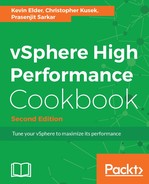High availability requires at least two HBA connections to provide redundant paths to the SAN or storage system.
Follow these steps to design high-performing storage:
- Having redundant HBAs mitigate the single point of failure and also increase performance. If you use more than one single-port HBA, then it helps to isolate port and path failures and may provide performance benefits. However, multiport HBA provides component cost savings and efficient port management, which results in operational simplicity. If you have only a few available I/O bus slots in your host, then multiport HBAs are useful, but you also have to consider a single point of failure. A single port HBA failure would affect only one port.
- You should put HBAs on separate host buses for performance and availability. This may not be possible on hosts that have a single bus or a limited number of bus slots. However, the likelihood of a bus failure is arguably so small that it is negligible.
- You should always use an HBA that equals or exceeds the bandwidth of the storage network. This means you should not use 8 Gb/s or slower HBAs for connections to 16 Gb/s SANs. This is mainly because FC SANs reduce the speed of the network path to the HBA's speed or to the storage system's frontend port if directly connected. It may create a performance bottleneck when you focus on optimizing bandwidth.
- Always use the most current HBA firmware and driver from the manufacturer.
- You can use NICs and/or iSCSI HBA for iSCSI environments. The differences include cost, host CPU utilization, and features such as security.
- Use the correct cables--Cat 6a or better for 10 Gb/s Ethernet and OM2 or better for 8 Gb/s and 16 Gb/s Fibre Channel.
- Ethernet networks will autonegotiate down to the lowest common device speed; thus, a slower NIC may bottleneck the storage network's bandwidth. If you use TOE, then it offloads TCP packet segmentation, checksum calculations, and optionally, IPSec from the host CPU to themselves. So, if you use TOE, then your CPU cycles will be used exclusively for application processing.
- To avoid a single point of failure, you should use redundant NICs, iSCSI HBAs, and TOEs wherever possible. You can use either single or multiport NICs. Typically, each NIC or NIC port is configured to be on a separate subnet, and this applies to IP storage and not ESXi networking in general. If you have more than one NIC, then you should place them on separate host buses.
Note this may not be possible on smaller hosts that have a single bus or a limited number of bus slots, or when the onboard host NIC is used.
